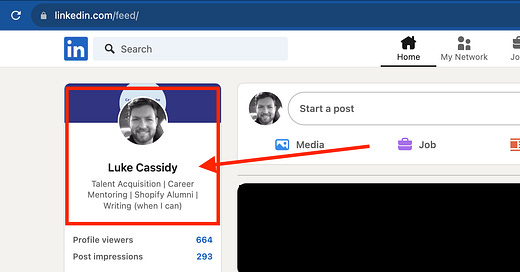Step by Step Guide to Networking on LinkedIn
A breakdown you can follow to grow your online network and improve your career prospects.
It’s coming into the end of year. Holidays are just around the corner. Many companies are wrapping up hiring (or trying to get the last few roles closed before break). Many folks are considering their current situation, role or company and asking the question - is it time for a change?
I’ve written about networking before while speaking about different topics (most recently about the “Hidden Job Market”), but I’ve had a lot of follow-ups asking for more specific advice and guidance.
You ask, and you shall receive. Let’s dive into how we can build our network using LinkedIn!
Defining Your Goal
Firstly, define are you trying to achieve with your networking? This will help build the most efficient and effective networking plan possible. There are three main reasons someone is looking to network.
Job Search
Pretty straightforward here. You either want or need a new job and are actively looking to make a move. If this is you, you’ll want to define your target role vs. a more general networking approach.
Connect with Peers
Connecting with peers is one of the easiest and least intensive ways to network. You don’t have the pressure of needing a new job, but you want to be proactive and ensure you are expanding your network to learn more about a specific company, industry or role.
Find a Mentor
Finding the right mentor can help accelerate your learning and growth. Sometimes mentors are easy to find, maybe it’s someone you know personally or work with. However, if a mentor isn’t readily available you may need to go searching. Networking can help.
Understanding Your Current Network
After setting your goal, you need to know where your starting from. Perhaps you have just set up your LinkedIn? Maybe it’s been laying dormant for years? Or potentially you’re super active and have a strong network already?
No matter what stage you’re at, try to uncover the connections you have already. You likely have some link to your target role, person or company - especially if you believe in the Six Degrees of Separation theory.
Your Current Network
Go to Linkedin.com and navigate to your Profile Page.
Once there, click on your connections.
Once on the Connections page, you will have the option to search with various filters.
To start, filter by their location or their company. This will help you identify your core network to build from.
Do a review of who you are connected with. Take note of anyone in relevant roles, industries or companies. Is anyone missing from your network like family, friends or colleagues? Add them.
How To Expand Your Network
There are a few different avenues you can take. You may find some more enjoyable or effective than others. The trick to effective networking it to be consistent and genuine.
LinkedIn Groups
Groups might seem like a strange place to start. Why should you care about groups?
LinkedIn has over 1 million groups on the platform. Some are very large (over 1 million members) and some are very niche.
You can send messages to other group members for free, without using an InMail.
You can easily send legitimate invitations to connect, with a higher acceptance rate.
The best way to leverage groups as a job seeker is to look for specific or niche groups around your area of interest. You’ll be surprised how many groups you’ll find.
Check out the “Digital Marketing” example below. The first page alone shows us 3 groups with 2 million members!
Once you’ve joined, view other members and search for folks via title or company. Not an exact science, but you should be able to find a few people you can connect with. Try this simple connection message out as a template:
Hi [name]
I’m [name]. Would love to connect to a fellow [group name] member. I’m very interested in [area/job/industry they are in] and would love to get your thoughts and perspective.
Alternatively, if you are connecting with someone who posted or commented something in the group
Hi [name]
I’m [name]. I saw your post on [topic] in the [group name] and thought it you had a very interesting perspective. Would love to connect.
As a recruiter I generally expect a 33% response rate from reach out work. So don’t be disheartened if you don’t hear back from everyone. That said, having the mutual group in common should help improve your response rate!
Thought Leaders
LinkedIn is like any social media platform. It has influencers and it has viral posts and content. Another great way to build a network is to follow industry/thought leaders on the platform.
While it’s unlikely (depending on who the person is) that every “influencer” will connect with you directly, you will be able to engage with and build relationship with other people through liking, sharing and commenting on direct posts.
Here’s a straightforward message template you can try out:
Hi [name],
[name] here. I loved your comment on the post from [name] about [post topic]. Would be great to connect!
Or if you are messaging the author of the original post, try:
Hi [name]
[name] here. Really enjoy your content, especially your recent post about [topic]. Would love to be connected!
Making a connection doesn’t always need to lead to a job referral or coffee chat. Sometimes making a connection is mutually beneficial. It helps both parties extend their network, making future networking easier.
Connect with the Friendly Outsiders
So you’ve built a strong core network of family and friends, joined relevant groups and followed industry thought leaders. If you did nothing else and continued to engage with all of those areas you’d be able to build a pretty solid network.
Amazing!
We’re not finished yet though.
The majority of networking advice out there boils down to adding the recruiter or hiring manager after you apply to a role to increase your chances of getting an interview.
This can be helpful, but putting time into consistently growing, supporting, engaging and growing your network is the best solution.
Cold messaging a Hiring Manager about how great you’ll be for their open role is one thing, having their work colleague (and your mutual connection) do it on your behalf because they genuinely think you’ll be great is a whole other level.
This is the impact a “friendly outsider” can have.
Alumni Groups
Did you attend a college or university? Chances are they have a LinkedIn page. If they do, you may have struck gold.
On a school’s LinkedIn page you can search your school’s Alumni.
From here, you can use the filter feature to narrow your search - using keywords or sorted criteria like graduation date, locations, skills, areas of study etc.
Remember when we defined your target role, company or industry? Well now we can search the alumni group for folks who work in or for those roles/industries or companies.
Like the Groups section above, connecting with alumni can be really easy. Make sure you don’t blindly ask for job referrals or recommendations. The goal should be to connect and build a genuine connection.
Here’s a message template you can try out:
Hi [name],
I would love to connect to a fellow [school name] alum! I see we have a similar interest and experience in [insert skills]. It would be great to chat with another person in the [industry] field.
[name]
Or alternatively:
Hi [name],
I see we both attended [school name], would love to connect on here!
Keep it short and sweet. Once connected, you can build a rapport with them. Perhaps even pick their brains on what it’s like at Y company or in X role!
Company
Like Universities with Alumni groups, companies with profiles on LinkedIn also have People pages. You can filter in a similar way, using keywords, locations, job titles and more to narrow a search.
As a networking tool this can be super powerful. You can connect directly with people doing the role you are interested in.
This can help you stay up to date on company news and information while also providing the opportunity to find out more about the role, team and potentially even hiring managers and leadership.
Hi [name]
Would love to connect. I’m a big fan of [company name] and would love to get your insight into what makes a great [role name] there. Your experience is very interesting!
Or if you really wanted to highlight a specific opportunity, try something like this:
Hi [name],
I’m [name]. I have an interest and experience in [insert skills]. I saw this job [link] online and wanted to see if you would be able to connect me with someone in that department or share a tip to gain visibility and increase my odds. I would be excellent because [insert suitability] .
Thank you,
[name]
The Right Recruiters
Outside of the Alumni and Company pages, another easy way to build extended connections is to reach out to and connect with recruiters. Recruiters, generally, have larger networks due to the nature of their role.
If we’re thinking about our 6 Degrees or Separation, connecting with relevant recruiters can supercharge your extended (2nd + 3rd degree) connections.
To find the right recruiters, look for:
Industry specific: find recruiters that specialise in your area of interest. You can search on Google to find relevant agencies or freelance recruiters, as well as searching LinkedIn for recruiters in your network directly.
Company specific: do your target companies have in-house recruiters? Connect with them. It’s a win-win for them. They connect with an interested candidate (and by proxy increase their network), and you connect directly with the folks hiring for the roles you want!
Location: Recruiters based in, or hiring in the region you live is helpful. Depending on your location, you may have local agency that specialise also.
How to Message
I’ve shared some sample messages throughout. They should provide a good starting base for you to build a message that is unique and reflective of you.
When in doubt, try to follow the Relate, Compliment, Add Value rule.
Relate to the person (find a connection)
Compliment the person (who doesn’t like a compliment)
Add Value (find a way to add value for them - don’t just ask for a favour)
Creating Content
The final piece to the networking pie is to create content.
By sharing posts, thoughts and advice or asking questions you can engage your existing network and connect with others outside of your network who see your posts.
Don’t worry, you don’t need to be LinkedIn’s next top voice. However posting once or twice a week can help organically grow a network of interested and engaged people.
To Wrap Up….
Take a walk down metaphor street with me… or should I say, metaphor garden.
Think of your career like a garden. You want to plant seeds (make connections) and water them (keep in touch, engage). Just like plants need each other to grow, your career benefits from a strong network.
Each seed grows into a unique plant that brings diversity and strength to your garden. Just like a garden with a variety of plants is more resilient, a career with a diverse network is more robust and full of exciting possibilities.
So, keep on planting those seeds, have patience and watch your garden career grow















